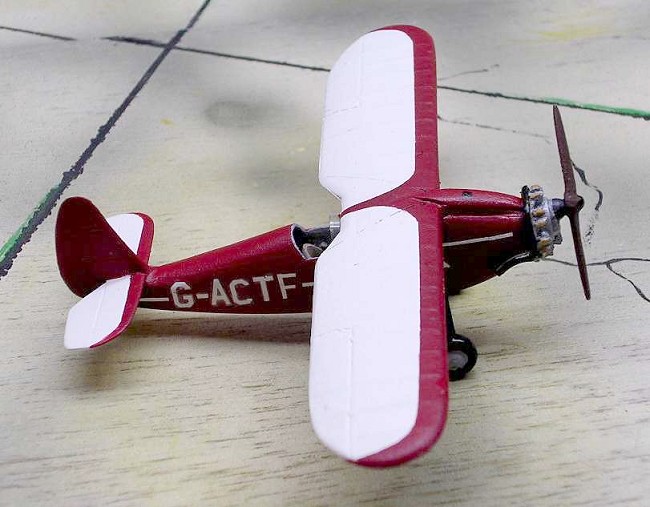
| KIT #: | ? |
| PRICE: | £5.00 |
| DECALS: | No options |
| REVIEWER: | Carmel J. Attard |
| NOTES: | Vacuformed plastic with metal parts |

| HISTORY |
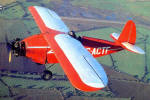 A quick
reference to the British Civil Aircraft Registration 0f the 1st
of January 1969 indicated that registration G-ACTF belonged to a CLA-7
Swift operated by Vintage Aircraft Group. The Swift in fact was a dainty
single seat sporting aircraft designed by Lt.Nicholas Comper in 1929 and
the CLA-7 was the only Comper type from three designs that went into
production. The prototype made its first flight at Brooklands on the 17th
May 1930.
A quick
reference to the British Civil Aircraft Registration 0f the 1st
of January 1969 indicated that registration G-ACTF belonged to a CLA-7
Swift operated by Vintage Aircraft Group. The Swift in fact was a dainty
single seat sporting aircraft designed by Lt.Nicholas Comper in 1929 and
the CLA-7 was the only Comper type from three designs that went into
production. The prototype made its first flight at Brooklands on the 17th
May 1930. Forty-one Swifts
were built; the earlier ones powered by different type of engine but were
eventually all fitted with Pabjoy engines including early series originally
fitted with 50 HP Salmson AD9 engines. G-ACTF was nicknamed “Scarlet Angel”
by its original owner, Alban Ali, an Indian tea-planter in Assam. Initially
it had an Indian registration VT-ADO. This aircraft flew
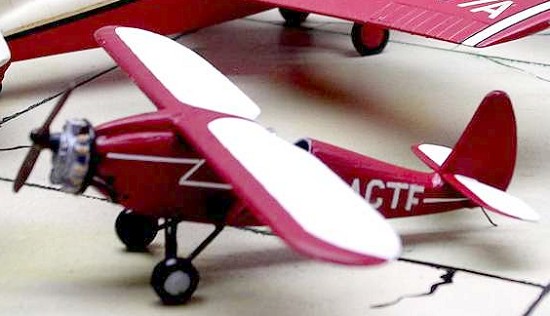 from Calcutta to Heston and also covered the 700 mile course at an average speed of 124 mph.
Alban Ali attempted to fly the Swift to England but flying over desert
terrain caused the engine to consume sand forcing it to make a stop due to
damage sustained. The rest of the journey to the UK was made in a wooden
crate and was eventually rebuilt by its new owner George Errington when it
was registered G-ACTF. It traveled to many airfields all over Europe and
again was bought by a new owner Ron Clear who converted it into a racing
configuration. This acquired a sliding hood and streamlined wheel spuds for
the Daily Express Race held in 1950. During this event G-ACTF placed 5th
establishing an FAI Class record of 141 mph.
from Calcutta to Heston and also covered the 700 mile course at an average speed of 124 mph.
Alban Ali attempted to fly the Swift to England but flying over desert
terrain caused the engine to consume sand forcing it to make a stop due to
damage sustained. The rest of the journey to the UK was made in a wooden
crate and was eventually rebuilt by its new owner George Errington when it
was registered G-ACTF. It traveled to many airfields all over Europe and
again was bought by a new owner Ron Clear who converted it into a racing
configuration. This acquired a sliding hood and streamlined wheel spuds for
the Daily Express Race held in 1950. During this event G-ACTF placed 5th
establishing an FAI Class record of 141 mph.
The Swift was a small and graceful single seat aircraft for its period. It was a braised high wing monoplane of wooden construction with fabric and plywood covering. The pilot sits in an open cockpit immediately aft of the leading edge. The Swift had a fixed tail skid instead of a wheel and one can imagine how in practice the skid ploughed a furrow through the wet grass and sodden soil and was known to have the tendency to slide sideways .Due to the blind forward view of the aircraft when on the ground the Swift needed to be weaved to ensure that the aircraft is taxiing in clear way. However once in the air visibility never seemed to be a problem. The instrument panel of Swift G-ACTF basically contained 7 instrument gauges to record engine revs, altitude, speed in knots and a compass. G-ACTF has been rebuilt three times in its life and was owned by Alan Chalkley of Blackbushe at one time.
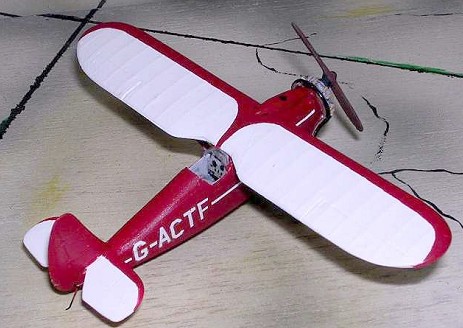 The logbook of
G-ACTF is known to contain several interesting feats achieved over the
historic flying span of 67 years. The Swift G-ACTF is the longest-lived of
its type and make. Construction number is S.32/9, built in 1932 and is
known to have remained on the British Aircraft Register in 1999 and often
located among light aircraft gathering at Shuttleworth. At least two other
Swifts survived in the UK. These include G-ABUS and G-ABUU. Comper Swift G-ACTF
was powered by a 75 hp Pabjoy R radial engine. It had a span of 24 ft. and
a length of 17ft 8.5inches. An all up weight of 985 lbs and 470 lbs when
empty. It attained a maximum speed of 140 mph, a cruising speed of 120mph.
and attained a ceiling of 22,000ft and a range of 380 miles. G-ABUS and G-ABUU
were spotted at Old Warden on one occasion on 29-6-69.Two Comper Swifts
went to Argentina, one of which made a record of 18,000 ft during crossing
of the Andes in 1932. Nine Swifts with Pabjoy engines were built at Haston
in 1931, two of which went to private owners in Tanganyika and Ireland.
Swifts made long distance flights and small airfields in the UK became
increasingly familiar with the soft whine of the Pabjoys turning the
big-geared propeller. Additional tankage to Swifts increased the range and
several found their way to South Africa and Australia.
The logbook of
G-ACTF is known to contain several interesting feats achieved over the
historic flying span of 67 years. The Swift G-ACTF is the longest-lived of
its type and make. Construction number is S.32/9, built in 1932 and is
known to have remained on the British Aircraft Register in 1999 and often
located among light aircraft gathering at Shuttleworth. At least two other
Swifts survived in the UK. These include G-ABUS and G-ABUU. Comper Swift G-ACTF
was powered by a 75 hp Pabjoy R radial engine. It had a span of 24 ft. and
a length of 17ft 8.5inches. An all up weight of 985 lbs and 470 lbs when
empty. It attained a maximum speed of 140 mph, a cruising speed of 120mph.
and attained a ceiling of 22,000ft and a range of 380 miles. G-ABUS and G-ABUU
were spotted at Old Warden on one occasion on 29-6-69.Two Comper Swifts
went to Argentina, one of which made a record of 18,000 ft during crossing
of the Andes in 1932. Nine Swifts with Pabjoy engines were built at Haston
in 1931, two of which went to private owners in Tanganyika and Ireland.
Swifts made long distance flights and small airfields in the UK became
increasingly familiar with the soft whine of the Pabjoys turning the
big-geared propeller. Additional tankage to Swifts increased the range and
several found their way to South Africa and Australia.
| THE KIT |
 Intrigued by a
set of prints that I accumulated over the years of this dainty light plane
I acquired the kit from Aeroclub of Nottingham. The kit contained accurate
scale plans, white metal propeller and engine parts, as well as injection
moulded wheels and vacuform parts for the fuselage, wings and tail planes,
seat and
Intrigued by a
set of prints that I accumulated over the years of this dainty light plane
I acquired the kit from Aeroclub of Nottingham. The kit contained accurate
scale plans, white metal propeller and engine parts, as well as injection
moulded wheels and vacuform parts for the fuselage, wings and tail planes,
seat and instrument panel. Two Contrail strips of different chord thickness
provided sufficient lengths for the under wing supports as well as tail
plane and undercarriage struts. There is appreciable amount of surface
detail on the fuselage and wing surfaces, which appeared to conform to the
drawings provided. The tiny prop and radial engine were accurately cast
intricately reproduced in detail and scale.
instrument panel. Two Contrail strips of different chord thickness
provided sufficient lengths for the under wing supports as well as tail
plane and undercarriage struts. There is appreciable amount of surface
detail on the fuselage and wing surfaces, which appeared to conform to the
drawings provided. The tiny prop and radial engine were accurately cast
intricately reproduced in detail and scale.
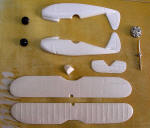
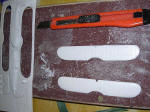 The instruction
sheet contained an exploded view of the parts of the model to identify and
facilitate the place of each part. The kit is vacuformed on a white plastic
sheet and contains ten parts. These are marked cut and separated from the
backing sheet and are sanded down on a medium grade wet and dry stuck on a
wooden board. Each component is frequently checked for its dimensions to
make sure not to go down too far at any one place during sanding. Practice
makes perfect and this kit is another good one to make a start on vacuform
but even so Aeroclub advises to read some of the many articles in the
modeling press.
The instruction
sheet contained an exploded view of the parts of the model to identify and
facilitate the place of each part. The kit is vacuformed on a white plastic
sheet and contains ten parts. These are marked cut and separated from the
backing sheet and are sanded down on a medium grade wet and dry stuck on a
wooden board. Each component is frequently checked for its dimensions to
make sure not to go down too far at any one place during sanding. Practice
makes perfect and this kit is another good one to make a start on vacuform
but even so Aeroclub advises to read some of the many articles in the
modeling press.
| CONSTRUCTION |
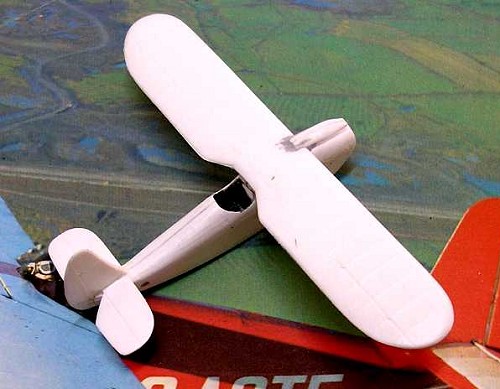 Once the parts
are brought to correct shape and thickness as per scale plans then the
mating surfaces should fit perfectly and the trailing edges of the flying
surfaces should be thin and sharp when held together. It is advisable to
detach the rudder from the fins that a slot can be made for the tail plane.
I preferred to leave the tail fin and rudder in one piece and shape the
tail planes at their root to bring a good contact section and butt jointed
these in place. The cockpit is very compact but even so an accurately cut
instrument panel, column and seat were fitted in place and once the
interior was painted light grey and each part pre-painted before fitted
inside.
Once the parts
are brought to correct shape and thickness as per scale plans then the
mating surfaces should fit perfectly and the trailing edges of the flying
surfaces should be thin and sharp when held together. It is advisable to
detach the rudder from the fins that a slot can be made for the tail plane.
I preferred to leave the tail fin and rudder in one piece and shape the
tail planes at their root to bring a good contact section and butt jointed
these in place. The cockpit is very compact but even so an accurately cut
instrument panel, column and seat were fitted in place and once the
interior was painted light grey and each part pre-painted before fitted
inside.
The vee-shaped front undercarriage legs were made from steel wire of the correct thickness and bent as per drawing. Two central holes were drilled at the inner face and at center of each wheel so that the legs are glued inside these prints. Other brackets or struts to the undercarriage and tail plane were shaped and cut from the Contrail struts provided. A circular exhaust ring with outlets was shaped from thin plastic. A semi circular windscreen, which was not provided with the kit, was made from thin clear acetate. After the fuselage parts were joined together and complete with cockpit detail in one piece the white metal engine was glue in position along with the exhaust ring and propeller.
| COLORS & MARKINGS |
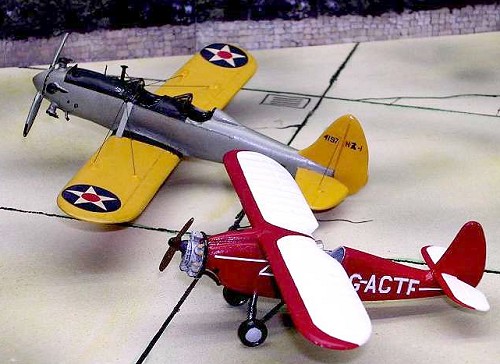 The instructions
suggest two paint schemes: G-ABWE a white overall with red trim and letters
with front panel in natural metal. VT-ADO, which is a former marking for G-ACTF
when owned by Alban Ali. The fuselage being all red with white lettering,
trim and edging to fin and rudder. The wings and tail were all white with
red leading edges and red lettering. This scheme is shown in one of the
accompanying photos. I preferred to do my replica of G-ACTF, ‘Scarlet
Angel’ in the later scheme which had no large lettering above the wings and
a slight variation in style to the fuselage lettering.(see photos).
The instructions
suggest two paint schemes: G-ABWE a white overall with red trim and letters
with front panel in natural metal. VT-ADO, which is a former marking for G-ACTF
when owned by Alban Ali. The fuselage being all red with white lettering,
trim and edging to fin and rudder. The wings and tail were all white with
red leading edges and red lettering. This scheme is shown in one of the
accompanying photos. I preferred to do my replica of G-ACTF, ‘Scarlet
Angel’ in the later scheme which had no large lettering above the wings and
a slight variation in style to the fuselage lettering.(see photos).
| CONCLUSIONS |
I enjoyed building this rather tiny pre-war, ultra light monoplane which made an amicable companion to other between-wars birds of the same feather such as the DH-53 Humming Bird, Bristol Fighter and the Ryan NR-1 Recruiter. Comper Swift G-ACTF was last known to belong to Brooklands Museum of Aviation, Weybridge. This was way back in 1990. It has since found its way to the Shuttleworth Collection Trust as I have seen it among other vintage aircraft at Old Warden, Cambridgeshire in May 2004.
August 2005
Copyright ModelingMadness.com
If you would like your product reviewed fairly and fairly quickly please contact the editor or see other details in the Note to Contributors.